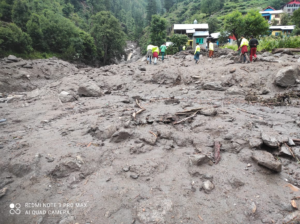| UPSC Relevance GS Paper I (Geography): Climate change, Western Disturbances, Himalayan ecosystems GS Paper II (Polity & Governance): Disaster management, role of IMD, NDMA GS Paper III (Environment): Climate change adaptation, ecological vulnerability of Himalayas Essay Paper: “Climate Change and Vulnerability of Himalayan States |
Why in News
A devastating flash flood in Chasoti village, Kishtwar district (J&K) killed at least 65 people and left over 50 missing. The tragedy highlights how climate change, rising temperatures, and shifting western disturbances are driving an alarming increase in extreme weather events in the Himalayas.
Background: Flash Floods in J&K
Flash floods are sudden surges of water triggered by intense rainfall over a short duration, often worsened by fragile mountain slopes, glacial melt, and poor preparedness.
- Between 2010 and 2022, Jammu & Kashmir recorded 2,863 extreme weather events leading to 552 deaths (IMD study, 2024).
- Frequent disasters included thunderstorms (1,942 events), heavy rain (409 events), flash floods (168 events), and landslides (186 events).
- While heavy snowfall caused the highest deaths (182), flash floods killed 119 people, mainly in Kishtwar, Anantnag, Ganderbal, and Doda.

The Rising Trend of Extreme Weather Events
Climate science shows that global warming is altering Himalayan weather systems. Three main factors contribute to disasters like Kishtwar:
1. Rising Temperatures in Western Himalayas
- The western Himalayas have warmed twice as fast as the Indian subcontinent post-2000.
- Warmer air holds 7% more moisture per 1°C rise, increasing rainfall intensity and duration.
- Glacial retreat has formed unstable glacial lakes; sudden breaches during heavy rains cause destructive floods downstream.
2. Changing Nature of Western Disturbances
- Western Disturbances (WDs) are east-moving moisture-laden winds originating beyond Afghanistan/Iran and fed by Mediterranean, Black, Caspian, and Arabian Seas.
- Traditionally winter phenomena, WDs now occur outside winter, bringing heavy rain and flash floods.
- Rapid Arabian Sea warming injects more moisture into WDs, intensifying rainfall in Himalayan states.
3. Fragile Topography of J&K
- The Himalayan terrain amplifies rainfall through orographic effects — moist air rises, cools, and condenses into intense precipitation.
- Steep slopes, deforestation, and unplanned construction worsen the disaster impact.
Climate Change Linkages
- The frequency and intensity of flash floods, landslides, and extreme snowfall are increasing.
- The shrinking cryosphere (glaciers, snow cover, glacial lakes) is a key risk multiplier.
- Global warming is not just changing rainfall distribution, but also creating compound disasters — where heavy rainfall combines with glacial lake outburst floods (GLOFs) or landslides.
Implications for J&K and India
- Human Security – loss of lives, displacement, and livelihood disruptions in vulnerable mountain communities.
- Infrastructure Risk – roads, hydropower projects, and defense installations are exposed to recurring disasters.
- Agriculture – erratic rainfall affects cropping cycles and food security.
- National Security – J&K’s sensitive border regions require stable logistics, now threatened by climate-induced disruptions.
Way Forward
- Early Warning Systems: Expand real-time flood forecasting and IMD monitoring in Himalayan districts.
- Glacial Lake Risk Mapping: Identify vulnerable lakes and prepare mitigation plans.
- Sustainable Infrastructure: Regulate construction, roads, and hydropower projects in fragile zones.
- Community Preparedness: Local-level disaster training and relocation plans.
- Climate Action: Strengthen India’s commitment to emission cuts and adaptation under the Paris Agreement.
Conclusion
The Kishtwar flash flood highlights the fragile Himalayan ecology, worsened by climate change, unplanned development, and weak preparedness. It shows the urgent need for resilient infrastructure, early warning systems, and community adaptation to safeguard lives and livelihoods in climate-vulnerable regions.
UPSC Practice Question
Q. Consider the following statements about Western Disturbances (WDs):
- They originate in the Mediterranean region.
- They bring rainfall mainly to the northwestern parts of India during winter.
- Recent climate change has extended their activity beyond winter months.
Which of the above statements are correct?
- (a) 1 and 2 only
- (b) 2 and 3 only
- (c) 1 and 3 only
- (d) 1, 2 and 3
Answer: (d)
Mains Practice Question
Q. Flash floods are becoming increasingly common in the western Himalayas. Discuss the role of climate change, western disturbances, and topography in this phenomenon. Suggest mitigation strategies.
SOURCE- THE INDIAN EXPRESS
Found this helpful?
Bookmark for revision, Practice the mains question, and
Share with fellow aspirants! THANK YOU
